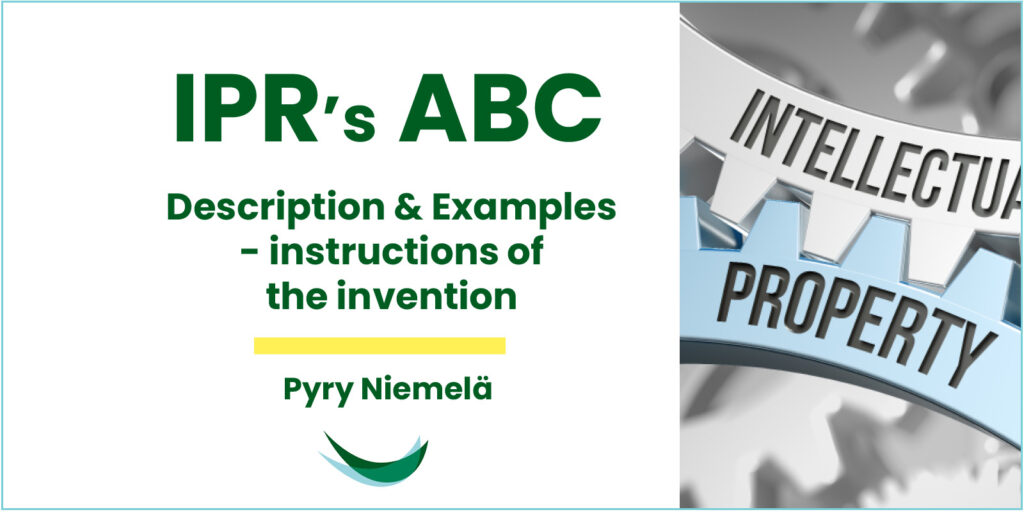IPR’s ABC | Description and expamples – instructions of the invention

- Pyry Niemelä
- –
- News
- –
- 25.2.2025

After reading the patent claims, someone interested in the invention may wonder, “How can this be put into practice?” The description of the patent will help you find the answer!
Description provides the information needed to carry out the invention
The purpose of the description is to provide the necessary support for the patent claims to enable the invention to be used. The description contains a short and a descriptive title for the invention, and a general and specific part describing the invention.
The general part describes the field of the invention and the prior art related to the invention, how the invention solves or improves upon the disadvantages of the prior art, and the means necessary to achieve this. The prior art may be presented, for example, by reference to earlier patent publications, although it is advisable to make as few references as possible to facilitate prosecution.
In the specific part, the invention is described in detail by means of embodiments and possibly by reference to drawings. For example, if the invention is a new type of lawnmower blade, the structure and function of the blade should be described in sufficient detail to enable a person skilled in the art to reproduce the blade and to understand its advantages over the prior art. It is not necessary to include all the details, such as the dimensions of the bolts used to secure the blade, if the advantages of the invention do not relate to them and are obvious to the person skilled in the art.
If the description includes a drawing, it is recommended to include a list of all the figures in the drawing as an introduction to a specific part of the description.
Examples show what your invention can do
Examples are necessary when the means for carrying out the invention and the advantages achieved over the prior art are not obvious from the described function or structure of the invention alone. For example, if a patent application alleges that a lawnmower blade according to the invention stays sharper for longer, an example of an experimental arrangement can be presented, in which a reference blade and a blade according to the invention are used for a certain period of time in conditions that similar to actual lawnmowing. Finally, the example may refer to a microscope image or a graph accompanying the drawings illustrating the difference in sharpness between the two blades after the experiment.
In patent applications, examples play an important role not only in demonstrating the differences between the prior art and the invention, but also in proving that the invention can be carried out. The lack of examples is particularly problematic in patent applications related to chemistry. The structural formula of a chemical compound can easily be set out in a patent claim, but if the person skilled in the art cannot make the compound on the basis of the description, invention is not sufficiently disclosed. Where a general structure for a group of compounds is claimed, it is beneficial to provide a wide range of examples of the preparation and the effects of compounds belonging to that group to credibly demonstrate the utility of the invention within the full scope of the claim.
Sometimes, the Office examiner may raise concerns about the sufficiency of the disclosure if the description has left doubt as to the applicability of the invention within the full scope of the patent claim. Although added subject matter cannot be introduced to the patent application, additional examples may be submitted to most offices to support the findings already presented in the description. Some deficiencies in the description may be difficult or even impossible to remedy after the filing of the patent application. Therefore, careful preparation of the patent application by a professional will help to ensure that your invention is successfully protected.
Any questions? Do not hesitate to contact our experts – we’re here to help you!

